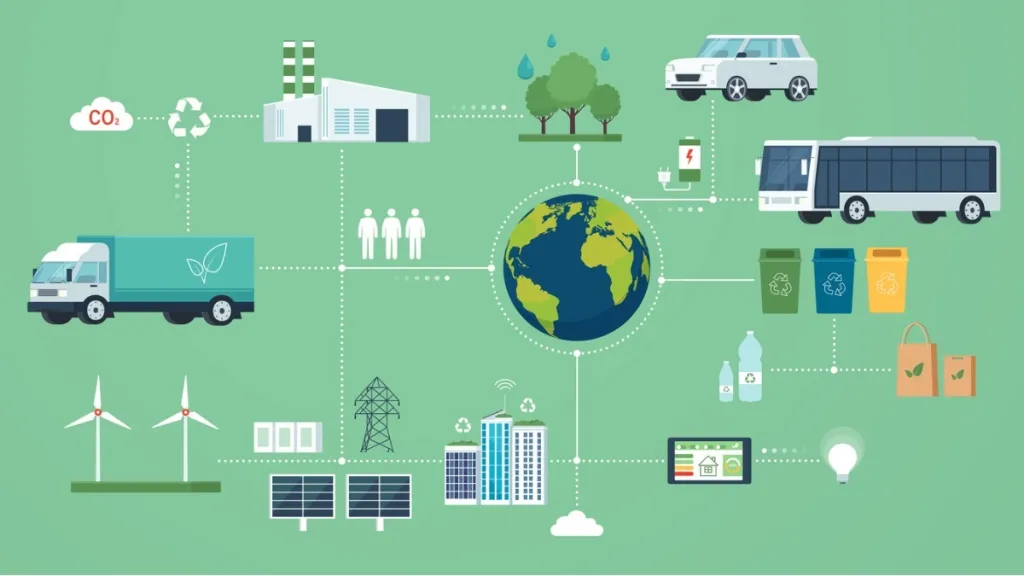
In light of the new regulations for sustainable supply chain, businesses need to ensure that they take into account the environmental, social, and economic impacts of their entire supply chain process. But what is a sustainable supply chain, and why is it important?
A sustainable supply chain is a business model that minimizes negative impacts on the environment, promotes social responsibility, and maintains economic viability. By adopting sustainable practices, companies can enhance their reputation, reduce costs, improve operational efficiency, mitigate risks, build resilience, and gain a competitive advantage.
In this blog, we’ll delve into why sustainable supply chain matters and give you insights on how your business can achieve sustainability in its supply chain. So, whether you’re a business owner or a concerned consumer, join us as we explore the importance of sustainable supply chain and how you can play a part in making a positive impact on the environment and society.
Why sustainable supply chain matters?
Environmental Impact
Adopting a sustainable supply chain can effectively reduce the environmental impact of a company’s production and distribution processes. By optimizing transportation, reducing waste, and incorporating eco-friendly materials, businesses can significantly decrease their carbon footprint. This approach not only helps protect the environment, but also lowers the risk of facing environmental regulations and associated liabilities. As consumers and regulators increasingly prioritize sustainability, implementing a sustainable supply chain is a smart strategy for businesses to future-proof their operations while demonstrating their commitment to protecting the planet.
Social Responsibility
A sustainable supply chain prioritizes social responsibility in the production and distribution of goods. This involves practices such as fair labor, ethical sourcing of materials, and a focus on social impact. Such an approach helps to prevent the exploitation of workers and communities, and safeguards human rights. By creating a supply chain that values social responsibility, businesses can build stronger relationships with customers, enhance their reputation, and differentiate themselves from competitors. In today’s world, where consumers demand transparency and ethical practices, a sustainable supply chain is a smart investment for businesses looking to thrive in the long run.
Economic Benefits
In addition to environmental and social benefits, sustainable supply chains can yield economic advantages. By optimizing processes, reducing waste, and utilizing renewable energy sources, companies can effectively lower costs and increase profitability. Furthermore, by implementing sustainable practices, businesses can attract customers who are willing to pay a premium for environmentally and socially responsible products. This can translate into increased revenue and market share, as well as stronger brand loyalty and reputation. Adopting sustainable practices isn’t just a moral imperative, it’s a smart business decision that can position companies for success in a rapidly changing global landscape
Risk Reduction
A sustainable supply chain can also help to reduce risks associated with environmental and social impacts. For example, companies that rely on non-renewable resources may face supply chain disruptions if those resources become scarce or are subject to political instability. In contrast, companies that prioritize sustainable practices are likely to have more stable supply chains and reduce risks associated with environmental and social issues.
How to Achieve a Sustainable Supply Chain?
1.Environmental impact assessment
The first step to achieve a sustainable supply chain is environmental impact assessment (EIA). It is crucial for businesses to use this tool to identify and understand the environmental impact of their operations and supply chains. By conducting a thorough EIA, businesses can identify areas where they can make improvements to reduce their environmental impact and work towards achieving their sustainable supply chain goals.
An EIA involves analyzing the environmental effects of the entire supply chain, including the extraction of raw materials, transportation, manufacturing, distribution, use, and disposal of products. This allows businesses to gain a comprehensive understanding of the environmental impact of their supply chain and identify areas where they can make improvements.
By conducting an EIA, businesses can also identify any regulatory or compliance requirements they need to meet. This can help them avoid fines or other penalties and ensure they are operating within legal requirements.
2. Establish clear sustainability goals and metrics
Second step is to set clear and measurable sustainability goals which involves establishing specific targets for reducing greenhouse gas emissions, minimizing waste, promoting ethical sourcing, and other sustainability objectives that align with the business’s values and commitments.
It’s important to establish metrics to track progress towards these goals, which can help identify areas that need improvement and provide data for reporting on sustainability performance. For example, a business may track its greenhouse gas emissions from transportation, manufacturing, and energy use, and set targets to reduce those emissions by a certain percentage each year.
3.Collaborate with suppliers
Collaborating with suppliers can provide a valuable source of assessment and feedback, allowing businesses to monitor supplier performance and identify areas of excellence or improvement. By tailoring assessments to the unique needs of each supplier, businesses can incentivize them to prioritize sustainability and build stronger partnerships for the future.
In addition, supplier collaboration can offer access to valuable resources that can help suppliers improve their sustainability practices. Since not all suppliers may have the necessary tools or knowledge to meet sustainability standards, businesses can work with them to provide resources and support, making the process more appealing and streamlined. By supporting suppliers in this way, businesses can accelerate their own progress towards a more sustainable supply chain.
4.Optimize transportation
Transportation optimization provides tools to evaluate and improve the competitiveness of existing freight operations, and to simulate strategic “what-if” scenarios. This helps businesses determine the most efficient transportation strategy, especially after supply chain network redesigns or cross-divisional consolidations. By addressing various supply chain issues, such as load efficiency, disruptions, delivery options, and regulatory changes, transportation optimization helps businesses improve their overall sustainability performance.
Optimizing transportation network not only leads to reduced fuel consumption and emissions resulting in a decreased carbon footprint, but also supports global initiatives to stabilize temperatures and mitigate the negative impacts of climate change.
5.Reduce waste
Reducing waste is a crucial component of achieving a sustainable supply chain. By reducing waste, companies can reduce their environmental impact and improve their bottom line. One way to achieve this is by adopting a circular economy approach, where waste is minimized and resources are kept in use for as long as possible. This can involve redesigning products for easier recycling, reducing packaging waste, and implementing sustainable disposal and recycling practices.
Another strategy is to conduct a waste audit to identify areas of waste and inefficiency in the supply chain. This can involve analyzing processes and procedures to identify areas for improvement, as well as engaging with suppliers and customers to find ways to reduce waste throughout the entire supply chain. By implementing waste reduction strategies and monitoring progress, companies can minimize their environmental impact while also improving their reputation and bottom line.
Conclusion
Dayrize’s cutting-edge technology for measuring the holistic and accurate impact of consumer products is a powerful asset for businesses that are committed to achieving their sustainable supply chain goals. With this advanced technology, companies can gain deep insights into their environmental impact, pinpoint areas for improvement, and make data-driven decisions that promote sustainability and profitability.

